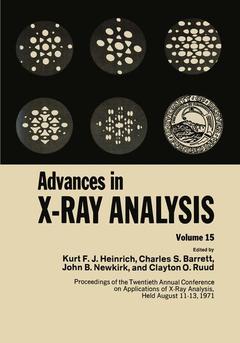Advances in X-Ray Analysis, Softcover reprint of the original 1st ed. 1972 Volume 15
Langue : Anglais
Coordonnateur : Heinrich K.

The application of solid-state detectors of high energy resolution to x-ray spectrometry, and the increasing use of compu ters in both measurement and data evaluation, are giving a new stimulus to x-ray techniques in analytical chemistry. The Twentieth Annual Denver X-ray Conference reflects this renewed interest in several ways. The invited papers, grouped in Session I, review the charac teristics of the detectors used in the measurement of x-rays. One paper is dedicated to the detection of single io.ns. Although such a subject may appear to be marginal to the purposes of the Denver Conference, we must recognize the affinity of techniques applied to similar purposes. Ion probe mass spectrometry is dedicated to tasks similar to those performed by x-ray spectrometry with the electron probe microanalyzer. Scientists and technologists will see these two techniques discussed in the same meetings. The discussion of automation and programming is not limited to the two invited speakers, but extends to papers presented in more than one session. The matter of fluorescence analysis by isotope- and tube-excitation will also be of great interest to those concerned with the practical applications of x-ray techniques. The communications contained in this volume, and the lively discussions which frequently followed the presentation of papers, attest to the vitality of the subjects which are the concern of the Annual Denver X-ray Conference.
The Application of High-Resolution Solid State Detectors to X-Ray Spectrometry--A Review.- Detection of Single Ions by Pulse Counting: Application to Ion Microprobe Mass Analyzer.- Application of Computers in Electron Probe and X-Ray Fluorescence Analysis.- Computer-Controlled X-Ray and Neutron Diffraction Experiments.- An Automated Two-Crystal Spectrometer Employing Direct Angular Positioning and Readout.- A Paper Tape Controlled X-Ray Diffractometer for the Measurement of Retained Austenite.- Automated X-Ray Diffraction Laboratory System.- X-Ray Diffraction Topography-Differential Omega Scanning Technique.- A Modular Automatic X-Ray Analysis System.- AN Automated Electron Microprobe System.- Rapid Quantitative Analysis by X-Ray Spectrometry.- On the Method of Variable Take-Off Angle for Quantitative X-Ray Fluorescence Analysis (XRFA).- An Automatic X-Ray Analytical Instrument for the Chemical Laboratory.- Energy Dispersive Analysis for Adjacent Elements Using Two Single Channel Analyzers.- Determination of Zirconium, Hafnium, Niobium, Tantalum, Molybdenum and Tungsten in Aqueous Solutions by Radioisotopic Excited X-Ray Fluorescence.- Fluorescence Analysis Using an Si(Li) X-Ray Energy Analysis System with Low-Power X-Ray Tubes and Radioisotopes.- Rapid Recording of Powder Diffraction Patterns with Si(Li) X-Ray Energy Analysis System: W and Cu Targets and Error Analysis.- A Complete Instrumental System for Energy Dispersive Diffractometry and Fluorescence Analysis.- Small X-Ray Tubes for Energy Dispersive Analysis Using Semiconductor Spectrometers.- Rapid Analysis of Mn in Plain Carbon Steels by Nondispersive X-Ray Fluorescence Spectroscopy.- The Use of Field Emission Tubes in X-Ray Analysis.- Old Errors and New Corrections in X-Ray Line Profile Analysis.- The Effects of Self-Irradiation on the Lattice of 238(80%)PuO2.- The Disorder-Order Transformation in Ni4Mo.- A Strategy for Rapid and Accurate (p.p.m.) Measurement of Lattice Parameters of Single Crystals by Bond’s Method.- X-Ray Spectral Distributions from Thick Tungsten Targets in the Energy Range 12 TO 300 kV.- Elemental X-Ray Cross Sections at Selected Wavelengths.- A Computerized Technique of Plotting a Complete Pole Figure by an X-Ray Reflection Method.- Proton-Induced X-Ray Emission Spectroscopy in Elemental Trace Analysis.- Use of a Solid-State Detector for the Analysis of X-Rays Excited in Silicate Rocks by Alpha-Particle Bombardment.- Studies of X-Rays Induced by Charged Particles.- Evaluation of X-Ray Intensifiers as Detectors for X-Ray Astronomy.- An Electro-Optical X-Ray Diffraction System for Grain Boundary Migration Measurements at Temperature.- Proposed Flash X-Ray System for X-Ray Diffraction with Submicrosecond Exposure Time.- Analysis of Solid Surfaces by Soft X-Ray Appearance Potential Spectroscopy.- Detector Background and Sensitivity of Semiconductor X-Ray Fluorescence Spectrometers.- The Measurement of Surface-Layer Stresses in a Polycrystalline Glass by Means of X-Ray Diffraction.- The Determination of the Axis of Lattice Rotation with Respect to a Change in Texture.- Simultaneous Spiral Recording of Pole Figures on Polaroid Film for Texture Goniometers.- X-Ray Double Crystal Diffractometer Investigations of Implanted Silicon: D+ and N+.- X-Ray Investigations of Spinel Substrates.- Cross Linking of Collagen by Hydrophobe Bonds.- Effect of Ion Exchange Resin Particle Size on X-Ray Fluorescent Analysis.- On-Line Process Control Compositional Analysis of Aluminum Films Containing a Low Percentage of Copper.- Flame Technique for High Temperature Single Crystal Weissenberg Photography (1000–3000°C).- Author Index.
Date de parution : 12-2012
Ouvrage de 573 p.
17.8x25.4 cm
Disponible chez l'éditeur (délai d'approvisionnement : 15 jours).
Prix indicatif 52,74 €
Ajouter au panierThème d’Advances in X-Ray Analysis :
© 2024 LAVOISIER S.A.S.



